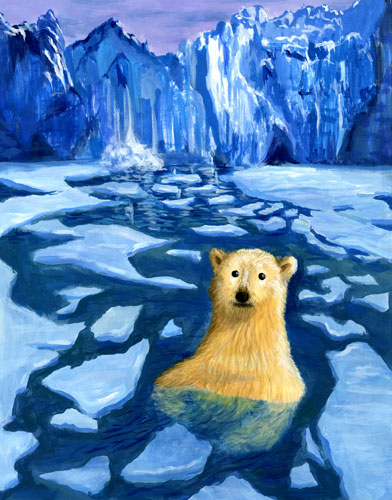 Overcast this Wednesday morning on California’s north coast, with rain expected at any minute — supposedly rain until Saturday, at least, and some forecast to be fairly-decent in downfall.
Overcast this Wednesday morning on California’s north coast, with rain expected at any minute — supposedly rain until Saturday, at least, and some forecast to be fairly-decent in downfall.
And cold-as-shit this morning, too. However, we on the shoreline are under an NWS ‘Frost Advisory,’ vs a few miles inland, and a ‘Freeze Warning.’ A degree-or-two a difference…
And a big imbalance is man-made climate change, which is already having impacts — via Wired this morning: ‘Climate change and its effect on the Arctic sea could cause polar bear numbers to fall by a third by 2050, according to worrying research by the US Fish and Wildlife Service in Anchorage, Alaska.’
Or how about the “hugely worrying” data from the quahog clam?
(Illustration found here).
Working against this impending reality, is bullshit of the ‘hugely worrying’ order.
An excellent recap from Dr. Jeff masters and Ron Henson at WunderBlog yesterday:
With just three years left to go, it’s virtually certain that the 2010s will be warmer than any decade on record, barring a massive volcanic eruption.
As greenhouse gases produced by human activity continue to build up in the atmosphere, it’s also a very good bet — again barring a volcanic or geopolitical cataclysm — that the 2020s will be warmer than the 2010s.
You wouldn’t know about these perfectly reasonable, science-based inferences if all you had to go by was this article published by Breitbart.com on November 30: “Global Temperatures Plunge. Icy Silence from Climate Alarmists.”
The article includes this statement: “The last three years may eventually come to be seen as the final death rattle of the global warming scare.”
Along with its presence on the high-profile Breitbart site, this article drew even more attention after a link to it was retweeted by the U.S. House Committee on Science, Space, and Technology.
Fortunately, the article has been effectively rebutted by several excellent bloggers (see links below).
Though we’d prefer to focus on our usual coverage of weather and climate science, in this case we felt it was important to add our two cents — especially because a video clip from weather.com (“La Niña in Pacific Affects Weather in New England”) was prominently featured at the top of the Breitbart article.
Breitbart had the legal right to use this clip as part of a content-sharing agreement, but there should be no assumption that The Weather Company endorses the article associated with it.
…
Scientific debate in this area is real and perfectly legitimate.
Likewise, how we respond to climate change is a matter of public policy, one that demands healthy debate and engagement from citizens and political leaders.
It’s something else entirely to foster suspicion about the very bedrock of climate change science, which is based on thousands of peer-reviewed studies and accepted by every major scientific organization on Earth.
Human-produced greenhouse gases are causing the Earth system to warm, and this trend will continue, along with shorter-term ups and downs.
There are too many important debates and decisions ahead of us to waste time on artificial ones.
Re-enforcing the situation — details on those polar bears:
Averaging all three projections, there is a 70 percent chance that polar bear numbers will drop by a third in the next 35-41 years.
The study was published in the Royal Society’s Biology Letters.
This week it was announced that sea ice off Antarctica and in the Arctic is at record lows for this time of year.
Arctic sea ice, which usually expands in winter, is at a record low of 10.25 million square kilometres (3.96m square miles).
Anders Levermann, a professor at the Potsdam Institute for Climate Impact Research, told Reuters that the low sea ice is a result of global warming and “an extraordinary departure from the norm”.
According to current trends, the Arctic could see its first ice-free summers sometime in the 2030s.
Penguins are being affected by the changes in sea ice too.
Earlier this year, a study by the University of Delaware announced the penguin population may drop by 60 per cent by the end of the century because of the warming of glaciers in Antarctica.
And on the the quahog clam:
Researchers examined growth rings on the shell of the edible mollusc, which can live for more than 500 years, to uncover details of a dramatic shift in the interaction between the North Atlantic Ocean and the atmosphere.
Before the industrial period began some 200 years ago, atmospheric fluctuations were caused by natural changes in the ocean, driven by volcanic eruptions and the sun’s radiation.
…
Professor Hall, head of Cardiff University’s School of Earth and Ocean Sciences, said the atmosphere and the oceans were “intimately coupled” because they both transport heat across the planet.
In the pre-industrial period, the world’s oceans “played an active role in driving atmospheric climate variability,” he said.
“It seems there’s been a shift in that relationship.”
…
“The atmosphere is warming much quicker and driving the ocean variability,” said Professor Hall.
This was a cause for concern “in the sense that man-made climate variability is hugely worrying,” he said, adding that the research could make it easier to accurately simulate and predict climate change in the future.
Added bonus graph from the article: ‘A separate study into climate change published last week found global warming to be beyond the “point of no return” and claimed its full impact has been underestimated because scientists haven’t taken into account a major source of carbon in the environment.’
We just have to polar-bear with it…